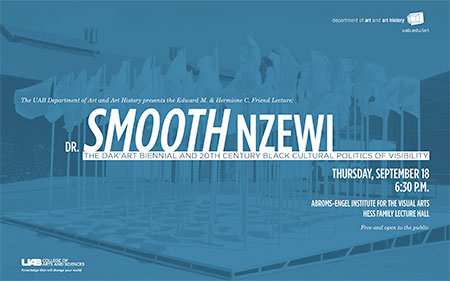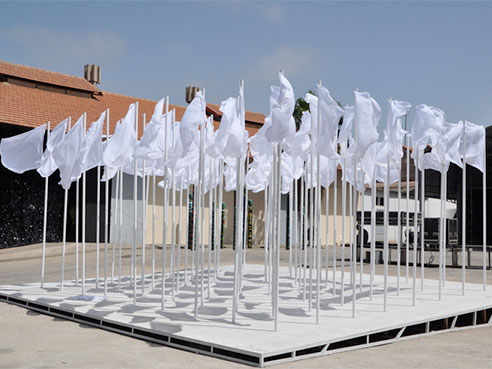 Artist, art historian and curator Ugochukwu-Smooth C. Nzewi, Ph.D., has been selected for the 2014 Edward M. and Hermione C. Friend Lecture at the University of Alabama at Birmingham, set for 6:30 p.m. Thursday, Sept. 18.
Artist, art historian and curator Ugochukwu-Smooth C. Nzewi, Ph.D., has been selected for the 2014 Edward M. and Hermione C. Friend Lecture at the University of Alabama at Birmingham, set for 6:30 p.m. Thursday, Sept. 18.
Nzewi’s lecture is “The Dak’Art Biennial and 20th Century Black Cultural Politics of Visibility.” It is presented by the UAB Department of Art and Art History and is free and open to the public. The lecture will take place in the College of Arts and Sciences’ Abroms-Engel Institute for the Visual Arts, Hess Family Lecture Hall, 1221 10th Ave. South. Call 205-975-6267 or visit the Department of Art and Art History online.
Nzewi is curator of African art at the Hood Museum of Art, Dartmouth College, Hanover, New Hampshire. He holds a Bachelor of Arts degree in fine and applied arts from the University of Nigeria, Nsukka, Nigeria; a postgraduate diploma in museum and heritage studies from the University of Western Cape, South Africa; and a Ph.D. in art history from Emory University. Nzewi has participated in international artists’ residency and workshop programs and more than 35 art exhibitions in Africa, Europe and the United States. He has curated exhibitions in Africa and the United States, including the Afrika Heritage Biennial in Nigeria in 2002, 2004 and 2007; “Transitions: Contemporary South African Works on Paper” at Atlanta’s High Museum in 2009; and the Dak’Art Biennial in 2014.
 Dak'Art 2014: 72 Virgins by Mehdi-Georges Lahlou. Photo credit, Ayo AdewunmiHis academic fellowships, scholarships and artists’ awards include a 2011 Robert Sterling Clark Foundation Fellowship and a 2012 Smithsonian Institution Pre-Doctoral Fellowship. His recent essays include “The Individual and Community: Aesthetics of Blackness in the Works of Three Black British Artists,” Critical Interventions, No. 12 (fall 2013); “The Contemporary Present and Modernist Past in Postcolonial African Art,” World Art Magazine, Issue 3, No. 2 (fall 2013); and “Curating Africa, Curating the Contemporary: The Pan-African Model of Dak’Art Biennial,” SAVVY: Journal of Contemporary African Art, [special edition on Curating: Expectations and Challenges] No. 4 (November 2012). He is a contributor to Grove Art Online’s summer 2014 update on African art and architecture, Oxford University Press, and co-editor of “New Spaces for Negotiating Art (and) Histories,” a forthcoming book on independent art initiatives in Africa.
Dak'Art 2014: 72 Virgins by Mehdi-Georges Lahlou. Photo credit, Ayo AdewunmiHis academic fellowships, scholarships and artists’ awards include a 2011 Robert Sterling Clark Foundation Fellowship and a 2012 Smithsonian Institution Pre-Doctoral Fellowship. His recent essays include “The Individual and Community: Aesthetics of Blackness in the Works of Three Black British Artists,” Critical Interventions, No. 12 (fall 2013); “The Contemporary Present and Modernist Past in Postcolonial African Art,” World Art Magazine, Issue 3, No. 2 (fall 2013); and “Curating Africa, Curating the Contemporary: The Pan-African Model of Dak’Art Biennial,” SAVVY: Journal of Contemporary African Art, [special edition on Curating: Expectations and Challenges] No. 4 (November 2012). He is a contributor to Grove Art Online’s summer 2014 update on African art and architecture, Oxford University Press, and co-editor of “New Spaces for Negotiating Art (and) Histories,” a forthcoming book on independent art initiatives in Africa.
The announcement of the creation of Dak’Art 1989 marked a pivotal moment in African and international art scenes, Nzewi says. President Abdou Diouf’s government had emerged from the worst part of Senegal’s economic crisis in the 1980s, and was ready to revert to international cultural diplomacy as crucial to national development and economic growth. The mainstream art world had also begun to re-examine the meaning of internationalism with groundbreaking exhibitions such as “Magicians of the Earth and Another Story.”
“Yet, these events at the twilight of the decade preceding the expansion of the art world and the emergence of new forms of cultural mediation in the 1990s do not fully explain what precipitated Dak’Art,” Nzewi said. “A full picture must include a rigorous engagement with 20th century global black cultural politics, which inspired and continue to drive Dak’Art’s geopolitical focus. This lecture maps this history.”
The early pan-African congresses and festivals, including the International Congress of African Culture in Salisbury, Harare, Zimbabwe, in 1962; the First World Festival of Negro Arts in Dakar, Senegal, in 1966; the First Pan-African Festival in Algiers, Algeria, in 1969; and the Second World Festival of Black and African Arts in Lagos, Nigeria, in 1977 made a case for black cultural visibility on a global scale. Significantly, they gave international recognition to modern black and African artists, a role currently championed by Dak’Art for contemporary artists of African descent, Nzewi says.
Ellen Elsas and her husband, Dr. Fred Elsas, established the Friend Lecture series in 2005 in memory of her parents, who were active supporters of the arts in the Birmingham community. With the objective to bring important and engaging speakers in the disciplines of art, art history and criticism to the UAB campus for the benefit of students and the community, the annual Friend Lecture has featured such noted curators, critics and art historians as Robert Storr, Tom Eccles and Ivan Gaskell.